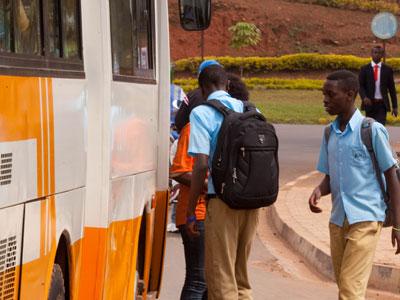For someone who runs or owns a transport company with over 20 buses, managing sales isn’t easy.


For someone who runs or owns a transport company with over 20 buses, managing sales isn’t easy.
Some buses set off with all passengers on board while others leave half empty or with just a handful of passengers. Yet the company may have more than eight centres from where passengers can purchase tickets. This makes supervision difficult.
Work made easier
However, new software has solved all these troubles. With this electronic payment system, the boss just sits back and monitors his/her sales on the phone at anytime of the day, says the CEO of Khenz Ltd, Moussa Habineza.
"Every transaction that is made is recorded in real time and the manager can see it without even leaving his bed. He has his records that he could even take to the bank and obtain a loan,” he says of some of the benefits of his company’s system.
For an intelligent man, this system can also be used to monitor his sales, the period when he needs more buses, the time of the day when most tickets are sold and finally the time and place to allocate his buses.
Marie Rose Kemigisha, who lives in Musanze but does business in Kigali four days a week, explains how electronic ticketing has made her life easier.
"With the electronic ticketing system, I can book my bus for the next day and just come a few minutes to the departure time. The old system required me to be at the bus park hours before departure since I had to book from the office but not any more,” she says.
The electronic point of sale is a hand-held machine that prints tickets on customer demand at stations and other off-bus locations in the form of electronic kiosks.
The new system is designed to mainly deal with cash although non-cash forms of payment are possible in some cases. It will however be much simpler in future through smart cards or a telephone-based payment system.
How it works
In the typical mode of operation, fare products, fare rules and prices are stored in the memory of this machine. On it are some buttons that are configured to various functions, ticket types and fares.
The seller who is usually the person who receives the money, selects functions, ticket types and fares according to the customer’s request. The ticket is then issued by this machine. A transaction record is created and stored, and cumulative counters are incremented. This is what the manager/owner views on their phone at anytime of the day.
In addition to issuing tickets for cash, these machines usually have the facility to record various categories of prepaid tickets and passes, and to issue a range of supplemental tickets.
***
ADVANTAGES OF TRANSPORTATION MONITORING SYSTEMS
Increased visibility
Today’s supply chain managers need to make quicker decisions based on real-time data. With increased visibility, companies become more agile and more responsive to changes.
Centralised control
Centralisation allows companies to make better use of shipment consolidation and pooling opportunities. Companies can now share travel schedules across departments and business units. This reduces costs and drives efficiency across the whole country.
Standardisation of processes
By breaking down each process into its component parts, companies can identify opportunities including unnecessary layers or steps. Once processes are understood, companies can start highlighting best practices as well as bad processes.
Automated processes
In the past, companies relied on manual processes to track and monitor travels. Processes were not synchronized and that created bottlenecks in the system. Automation allows today’s supply managers to manage more complex processes. Automated processes allow organizations to reduce cycle time and resources required.
Greater collaboration
With increased collaboration, supply chain partners are identifying opportunities not just for their business units, but opportunities that affect the entire fleet.
Compiled by Patrick Buchana


